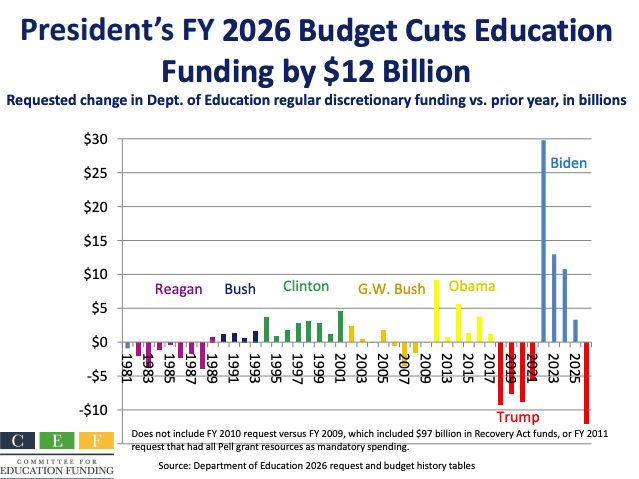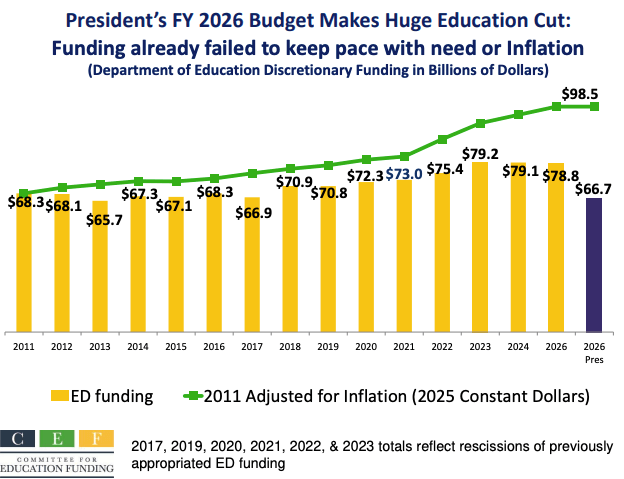Trump reduce fuerte gasto en niños

Por qué es importante y qué puede hacer
La propuesta de presupuesto federal para 2026 de la administración Trump incluye recortes alarmantes a servicios esenciales que apoyan a niños y familias, incluida la educación. Esta publicación resume la propuesta, explica sus implicaciones y sugiere acciones que su puede tomar para oponerse, adaptarse o ambas cosas.
Ninguno de los recortes propuestos por el Presidente es una sorpresa — reflejan ideas esbozadas en un documento conocido como Project 2025, que anunció audazmente estos objetivos:
- Eliminar el Departamento de Educación.
- Restaurar el control del gobierno local y estatal.
- Desviar fondos de las escuelas públicas para destinarlos a escuelas privadas y religiosas.
- Eliminar la financiación federal del programa Título I para la educación de estudiantes de bajos ingresos en un plazo de 10 años.
- Prohibir la Teoría Crítica de la Raza e incrementar los derechos de los padres.
- Hacer cumplir los derechos civiles con base en una comprensión “adecuada” de esas leyes, rechazando la ideología de género y la teoría crítica de la raza.
- Fortalecer las protecciones para instituciones y programas educativos basados en la fe.
Cómo se compara la propuesta de Trump
Los dos gráficos a continuación comparan el presupuesto educativo propuesto por Trump con propuestas de presidentes anteriores y con la inflación. Como muestra el primer gráfico, Trump ha propuesto recortes mayores en educación que los propuestos por presidentes anteriores:

Las propuestas de presupuesto deben pasar por un proceso legislativo. La mayoría de las veces, las propuestas (ya sean aumentos o recortes) se moderan en ese proceso. Como muestra el gráfico a continuación, con el tiempo, las cantidades efectivamente aprobadas para la educación en el presupuesto federal han fracasado incluso en mantenerse al nivel de la inflación.

El fracaso en seguir el ritmo de la inflación se traduce en recortes al personal docente en las escuelas locales. El impacto es mayor en los niños de comunidades con altos niveles de pobreza, porque dependen en mayor medida del apoyo federal.
Los presupuestos reflejan valores
Aunque el financiamiento federal representa una parte pequeña del total del financiamiento educativo, tiene un gran impacto en los niños más necesitados. El compromiso federal de ayudar a los niños necesitados mediante la educación se remonta a la Guerra contra la Pobreza en la década de 1960. El presidente Johnson transformó un compromiso moral para hacer de Estados Unidos un país más equitativo en acciones mediante programas federales.
Los únicos “ganadores” en el presupuesto educativo de Trump son las escuelas chárter.
Para comparar, observe los valores implícitos o declarados en la propuesta presupuestaria de Trump. Los únicos “ganadores” son las nuevas escuelas chárter, que recibirían $60 millones ($0.06 mil millones) en todo EE.UU. Todo lo demás pierde.
Escuelas públicas tradicionales:
Las escuelas en todo el país recibirán menos financiamiento del gobierno federal. El presupuesto propuesto por Trump recorta la educación pública en $12,000 millones.
Estudiantes de inglés y niños migrantes.
Hay recortes profundos a programas que apoyan a estudiantes de inglés y a niños migrantes.
Programas de diversidad, equidad e inclusión. (DEI)
Un tema importante en todo el presupuesto de Trump es eliminar los programas diseñados para abordar desigualdades históricas como el racismo y la desigualdad de ingresos.
Niños de bajos ingresos.
El dinero federal del Título I apoya a escuelas en comunidades de bajos ingresos. La propuesta presupuestaria de Trump en general preserva esta financiación — una pequeña victoria — pero no sigue el ritmo de la inflación.
Niños con necesidades especiales.
La ley federal (IDEA) exige que las escuelas públicas de todos los estados eduquen a todos los niños, incluyendo específicamente a los estudiantes que necesitan educación especial. Esta ley estableció la expectativa de que los fondos federales cubran hasta el 40% de los costos incrementales de la educación especial, y que el resto sea cubierto por estados y distritos locales. En la práctica, el presupuesto federal ha cubierto mucho menos de esta proporción — alrededor del 12 por ciento — dejando a los estados y distritos escolares con la responsabilidad. Para cumplir con las obligaciones de IDEA, los distritos recortan fondos de servicios básicos. Una propuesta de reforma sugiere diluir aún más esta financiación mediante un programa similar a un vale que entregaría dinero público a escuelas privadas y religiosas.
Derechos civiles.
Los recortes en la Oficina de Derechos Civiles limitan la capacidad de proteger los derechos en educación especial mediante litigios.
Rendición de cuentas.
El presupuesto propuesto elimina muchos programas educativos que fueron creados para atender necesidades específicas, redirigiendo los fondos a subvenciones globales. Por ejemplo, los programas del Título I y la IDEA incluyen requisitos y protecciones importantes para los estudiantes y sus familias. Las subvenciones globales propuestas no incluyen estas protecciones. El resultado es la pérdida de supervisión federal y rendición de cuentas.
Salud infantil y familiar.
El presupuesto recorta o elimina muchos programas diseñados para apoyar la salud.
Artes, humanidades y radiodifusión pública.
Hay recortes significativos a programas que apoyan la educación de niños y familias.
Propuesta presupuestaria de Trump 2026 para educación K-12
La siguiente tabla resume la propuesta presupuestaria de Trump, incluida la justificación expresada por la administración para los recortes. La columna de la derecha proporciona contexto. Para noticias sobre este tema mientras avanza el proceso presupuestario, consulte EdSource.
|
Propuestas presupuestarias federales para la educación K-12, 2026 |
||
|---|---|---|
|
Cambio en el programa vs. 2025 |
Justificación de la administración Trump |
Contexto |
|
Aumento de $60 millones |
“El presupuesto invierte $500 millones, un aumento de $60 millones, para expandir la cantidad de escuelas chárter de alta calidad, las cuales han demostrado mejorar el rendimiento académico de los estudiantes y brindar más opciones a los padres en la educación de sus hijos”. |
La lección 5.5 de Ed100 explica las escuelas públicas chárter. Hay algunas excelentes escuelas chárter, y también muchas ordinarias. |
|
Sin cambios* |
“Se preserva el financiamiento completo para el Título I, que proporciona asistencia financiera suplementaria federal a los distritos escolares para niños de familias de bajos ingresos.” |
* El “financiamiento completo” propuesto no considera la inflación, lo que significa una pérdida de servicios en las escuelas. |
|
Recorte de $4,535 millones |
“Consolida 18 programas de subvenciones competitivas y fórmulas en una nueva subvención de fórmula de $2 mil millones diseñada para reducir la influencia del Departamento de Educación en las escuelas y los estudiantes, y reducir la burocracia. “Este nuevo enfoque permite a los estados y distritos enfocarse en materias básicas—matemáticas, lectura, ciencias e historia—sin las distracciones del DEI y la politización del gobierno anterior.” |
* ED se refiere al Departamento de Educación de EE.UU. ** DEI es la sigla en inglés de Diversidad, Equidad e Inclusión. Hay preocupación de que recortes de esta magnitud llevarán a reducciones importantes en programas de los que dependen estudiantes y familias, como programas extracurriculares y de verano. Los costos directos de los programas DEI K-12 son mínimos en comparación. |
|
Financiamiento para educación especial Sin cambio en el financiamiento, pero cambios importantes en políticas |
“Consolida siete programas de la Ley IDEA para proporcionar a los estados y distritos escolares mayor flexibilidad para apoyar a estudiantes con necesidades de educación especial, manteniendo el financiamiento al nivel de 2025. “Los padres de estudiantes con discapacidades seguirían teniendo el poder de dirigir estos fondos, ya que la ley federal IDEA seguiría vigente; “Mantener un conjunto base de fondos federales significa que también pueden retirarse de estados y distritos que violen los derechos parentales.” |
El financiamiento propuesto sigue estando significativamente por debajo de las necesidades de los estudiantes. Las referencias de la administración Trump a los “derechos parentales” incluyen interpretaciones que podrían permitir dirigir fondos a escuelas privadas y religiosas. La administración Trump está investigando la prohibición estatal de revelar la identidad trans de los estudiantes. |
|
Recorte de $890 millones |
El presupuesto propone eliminar el programa de Adquisición del Idioma Inglés, incorrectamente nombrado, el cual en realidad devalúa la primacía del inglés al financiar ONG y estados que fomentan el bilingüismo. |
El presupuesto busca explícitamente eliminar el apoyo a programas que ayudan a los estudiantes a desarrollar habilidades multilingües, limitando en su lugar la educación solo al inglés. Para contexto, vea el blog de Ed100 La ventaja del bilingüismo. |
|
Educación para migrantes y programas especiales para estudiantes migrantes Recorte de $428 millones |
“El presupuesto elimina programas que perjudican el éxito académico de los niños al fomentar el desplazamiento en lugar de la estabilidad en un solo lugar.” “Estos programas no han demostrado ser efectivos, son extremadamente costosos, y alientan a no ciudadanos no elegibles a acceder a instituciones de educación superior, restando recursos a los estudiantes estadounidenses.” |
Los niños no eligen a sus padres. En las zonas agrícolas del estado es común que los trabajadores migrantes se muden en función del trabajo, llevando consigo a sus hijos. Muchos de estos niños son ciudadanos estadounidenses. De cualquier forma, tienen derecho a una mejor vida a través de la educación. Para más información, vea la lección 2.9 de Ed100 Estudiantes indocumentados |
|
Recorte de $127 millones |
“El presupuesto asigna $293 millones para la administración de programas, una reducción de $127 millones, o 30 por ciento.” |
El Departamento de Educación federal desempeña un papel esencial en hacer cumplir los derechos civiles en la educación. Los datos recopilados por el gobierno federal son esenciales para superar el ruido y la variabilidad entre los estados, y para descubrir qué funciona. Véase la lección 7.2 de Ed100 sobre el gobierno federal. |
|
Asociaciones para la calidad docente Recorte de $70 millones |
“El presupuesto propone terminar con el uso de fondos federales para adoctrinar a nuevos docentes.” “Además, muchas de estas subvenciones incluían estrategias de reclutamiento de maestros y personal basadas de manera implícita o explícita en la raza.” |
La lección 3.1 de Ed100 explica el desafío del reclutamiento docente. En California y en otros lugares, la profesión docente está dominada por mujeres blancas. Tiene sentido reclutar activamente candidatos docentes de forma más diversa. |
|
Servicios de capacitación y asesoría — Centros de Asistencia para la Equidad Recorte de $7 millones |
“El presupuesto elimina los Centros de Asistencia para la Equidad que han adoctrinado a los niños. Los fondos se han utilizado para obligar a los distritos locales a implementar prácticas DEI dictadas por Washington en contra de su voluntad.” |
Este pequeño programa ofrecía asistencia de asesoría. |
|
Oficina de Derechos Civiles (OCR) Recorte de $49 millones |
“Para dejar de enfocarse en casos relacionados con DEI y personas trans bajo el Título IX, el presupuesto asigna $91 millones a la OCR, una reducción de $49 millones, o 35 por ciento, respecto al nivel aprobado en 2024.” “Con este nivel de financiamiento, la OCR seguiría asegurando que las escuelas e instituciones que reciben fondos federales para programas educativos cumplan con las leyes federales de derechos civiles y las órdenes ejecutivas presidenciales, mientras se elimina su capacidad de impulsar programas DEI y promover ideologías radicales sobre personas trans.” |
Estos recortes forman parte de un esfuerzo explícito por desalentar a la Oficina de Derechos Civiles de cumplir una parte esencial de su función: proteger a los estudiantes contra la discriminación basada en identidad de género u orientación sexual. La mayoría de las personas no se dan cuenta de que este tipo de protección afecta directamente a aproximadamente una quinta parte de los estudiantes, como se explica en la lección 2.1 de Ed100. |
|
Subvenciones para el desarrollo de la educación preescolar (PDG) Recorte de $315 millones para la educación temprana. |
Elimina el programa. |
Lección 4.1 de Ed100: Educación preescolar: sí, la educación temprana importa. |
Otros recortes propuestos que afectan a niños y familias
|
Otros recortes con consecuencias para niños y familias |
||
|---|---|---|
|
Recortes |
Justificación de la administración Trump |
Contexto |
|
Eliminación de agencias pequeñas Recorte de $3,586 millones Entre las agencias eliminadas se encuentran: - Corporación de Radiodifusión Pública - Instituto de Servicios de Museos y Bibliotecas |
“El presupuesto incluye la eliminación total o de financiamiento federal para las siguientes agencias pequeñas, en consonancia con los esfuerzos del Presidente para reducir el tamaño del gobierno federal, mejorar la rendición de cuentas, reducir el desperdicio y eliminar entidades gubernamentales innecesarias.” |
Lección de Ed100: Las artes son fundamentales en el aprendizaje infantil Ed100: Humanidades La necesidad de comprendernos y tener empatía mutua nunca ha sido mayor. |
|
Programas de los CDC (Centros para el Control y la Prevención de Enfermedades) Recorte de $3,588 millones |
“El presupuesto elimina programas duplicados, de DEI o simplemente innecesarios.” |
Blog de Ed100: Salud y aprendizaje: ¿Qué pueden hacer las escuelas? |
|
Institutos Nacionales de la Salud (NIH) Recorte de $17,965 millones |
“Los NIH han traicionado la confianza del pueblo estadounidense con gastos innecesarios, información engañosa, investigaciones arriesgadas y la promoción de ideologías peligrosas que socavan la salud pública.” |
Blog de Ed100: Salud y aprendizaje: La salud física y mental influye en el aprendizaje. |
|
Administración de Servicios de Abuso de Sustancias y Salud Mental (SAMHSA) Recorte de $1,065 millones |
“El presupuesto propone reenfocar las actividades anteriormente parte de SAMHSA y reducir el despilfarro eliminando financiamiento ineficiente.” |
Blog de Ed100: Salud mental para el aprendizaje Las comunidades escolares reconocen cada vez más que los desafíos socioemocionales de los niños deben abordarse para que puedan aprender. |
|
Programas de salud: Recorte de $180 millones - Administración para una América Saludable - Programa de Prevención de Riesgos Sexuales y Embarazo Adolescente |
“En consonancia con la reorganización del HHS recientemente anunciada, el presupuesto reubica estos programas dentro de la nueva Administración para una América Saludable.” |
Blog de Ed100: Educación sexual en California |
Aquí vienen los abogados
Incluso antes de la publicación del presupuesto propuesto, la administración Trump emitió órdenes ejecutivas para implementar elementos de la agenda de Project 2025. Para más detalles, lea: Recortes federales por venir en educación.
Estas órdenes ejecutivas han sido enfrentadas por una oleada de demandas judiciales. Education Week es un excelente recurso para conocer los detalles de cada demanda y su estado a medida que avanzan en los tribunales.
¿Qué es un “presupuesto flaco”?
El presupuesto publicado en mayo se llama “presupuesto flaco” porque omite muchos detalles. Reduce el financiamiento para la educación en un 15%. La propuesta presidencial completa, que se espera para más adelante en junio, completará los detalles faltantes. Para más información sobre los plazos del presupuesto, consulte este resumen del proceso presupuestario federal.
Corresponde al Congreso adoptar un presupuesto final y presentarlo al presidente. En el mandato anterior de Trump, el Congreso actuó con independencia — no adoptó los profundos recortes a la educación que él propuso. Pero este es otro Congreso y otro momento. Los representantes estarán atentos a los comentarios del público al tomar sus decisiones.
Tome acción
Parte de nuestro proceso democrático es la posibilidad de expresar sus opiniones sobre temas importantes a los funcionarios electos. Contacte a su representante en el Congreso. Ahora es el momento.
Muchas organizaciones han expresado su preocupación sobre el impacto del presupuesto en la educación, los niños y las familias. A continuación, una lista donde su puede revisar sus posturas, sumar su voz o unirse a acciones colectivas.
Programas extracurriculares y de verano
Fundación Nacional para las Artes:
Instituto de Servicios de Museos y Bibliotecas
- American Alliance of Museums – Campaña por el IMLS
- American Library Association – Campaña por el IMLS
Fundación Nacional para las Humanidades
- National Humanities Alliance – Campaña por el NEH
- Federation of State Humanities Councils – Campaña por el NEH
Financiamiento para la educación
- National PTA
- National Education Association (NEA)
- American Federation of Teachers (AFT)
- National School Boards Association (NSBA)
Salud y recortes a los Institutos Nacionales de Salud
Etiquetas de esta publicación
Todas las etiquetas
Academia Khan Acoso acreditación Actitud Administradores Agallas Álgebra Ambiente escolar Aprendizaje Aprendizaje Ampliado Aprendizaje basado en proyectos Aprendizaje socioemocional Artes Asistencia Asociación de Maestros de California Asociación de Padres y Maestros Atención plena Ausencias Bonos de obligación Brecha de desempeño Burbank Calidad Calificación de escuelas Calificaciones en pruebas Cambio Canción Carol Dweck Carrera Cerebro Certificación CHAMP Ciencia Cierre de escuelas Civismo Comparaciones nacionales Concurso Consejeros Consejo escolar Control local Costo de educación Creatividad Crecimiento económico Crucigrama CSBA Currículo común cursos de estudios étnicos Datos Después de clases Día de la Independencia Diálogo dislexia Distritos Diversidad Dotado DREAM Act EACH EdPrezi EdSource EdTech Educación bilingue Educación del carácter Educación especial Educación religiosa Educación sexual Educación universal Elección Elección de escuela Enlaces guía Equidad Escasez de maestros Escuelas católicas Escuelas chárter Escuelas comunitarias Escuelas en casa Escuelas Magnet Escuelas privadas Escuelas religiosas Esfuerzo Estándares Estudiantes en riesgo Estudiantes que están aprendiendo inglés estudiantes sin hogar Estudios étnicos Evaluación Evaluación nacional de progreso educativo Éxito Federal Filantropía Financiamiento Financiamiento local Fondos por categorías Fundaciones educativas Ganadores Gastos Gobierno local Gráfica Grupos de presión Guía para padres líderes Historia Horas de oportunidad Huelga Humanidades Impuestos a la propiedad Impuestos prediales Índice de desempeño académico Indignación Indocumentado Infraestructura Iniciativas Instalaciones Internacional Investigación Jerga Kindergarten La Ley Brown LCFF Lectura Ley Cada Estudiante Triunfa Ley Que Ningún Niño Se Quede Atrás Liderazgo Límites de distritos Litigación Lotería Maestros mantequilla de cacahuate Mapa Mapa del sitio Marcador Matemáticas Medios de comunicación Mejoramiento Continua Mito Mitos Motivación estudiantil Negociación colectiva Negocio Niñez temprana Noticias falsas Nutrición Organizaciones de gestión para escuelas chárter Padres Pandemia Participación de los padres Pedagogía Pensiones personalizado PISA Plan de responsabilidad de control local Planificación Plantilla Población Pobreza Política Política federal Políticas Premio Prescolar Presupuestos Prezi Proposición 13 Proposición 98 Propósito de la educación Pruebas Reclutamiento de maestros Reforma Requisitos ag Responsabilidad Resumen del año Retención de maestros Rigor rompecabezas Rúbrica de evaluación Salario de maestros Salud Salud mental Se necesita ayuda Serrano vs Priest Sindicatos Sorteo SPSA STRS Sueño Suicidio Superintendente Suspensiones Tablero Talento Tamaño de clases Tareas escolares Tasas de graduación Tecnología Tecnología en la educación Tiempo dedicado a la tarea Tiempo en la escuela Trump Universidad Vacunación Vales Valores Vapeando Verano Vídeo Voluntariado Voluntarios Voto Voz del estudiante¡Compartir es vivir!
Restablecer contraseña
Buscar aquí en el contenido del blog y todas las lecciones.
Iniciar sesión con correo electrónico
We will send your Login Link to your email
address. Click on the link and you will be
logged into Ed100. No more passwords to
remember!














Preguntas y comentarios
Para comentar o responder, por favor inicie sesión .